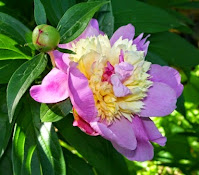 |
| Peony flower and buds |
Peonies are long-lived flowering shrubs that bloom in spring. Peony shrubs feature fragrant spring flowers, green glossy summer foliage, and vibrant red-hued leaves in fall. Once established in your garden the peony will grow seasonally for up to one hundred years
Many people grew up with peonies as the plant may have been divided from their grandmother's peonies and the peonies are passed down as an heirloom, thus making the peony a cherished flowering shrub.
Peonies do not like to be disturbed so choose your garden site wisely. It is best to plant the peony and then let it be. If you transplant to another location in your yard, your peony will punish you for not blooming for the next two to three years.
Choose the garden site for the peony that features full sun to part shade, well-drained soil, and adequate growing space. If you are planting more than one peony, spaced three feet apart.
Choose the garden site for the peony that features full sun to part shade, well-drained soil, and adequate growing space. If you are planting more than one peony, spaced three feet apart.
What season is best for planting peony?
Plant nursery-grown peony plants in the spring and plant peony tubers in the fall. Fall planting should be done from August through September. It is not recommended to plant the peony tubers later than September as it will not give the roots enough time to establish prior to the fall frost.
How do you Plant Peony flowering shrubs?
Purchase a nursery-grown peony in spring after the danger of frost has passed. Clear the garden site of grass, weeds, and rocks.
in spring after the danger of frost has passed. Clear the garden site of grass, weeds, and rocks.
Loosen the soil so that it has a fine texture. Work compost into the soil and then dig a hole that is the same depth as the nursery container.
At the bottom of the hole mix some bone meal for flowers
for flowers and bulbs with the soil. Lightly shake the soil from the roots of the peony. I do this to encourage growth. Set the peony in the center of the hole with roots facing outward.
and bulbs with the soil. Lightly shake the soil from the roots of the peony. I do this to encourage growth. Set the peony in the center of the hole with roots facing outward.
The peony eyes need to be two inches below the soil line. If you should plant the eyes deeper the peony will not produce flowers, or the flowers will be small.
Loosen the soil so that it has a fine texture. Work compost into the soil and then dig a hole that is the same depth as the nursery container.
At the bottom of the hole mix some bone meal
The peony eyes need to be two inches below the soil line. If you should plant the eyes deeper the peony will not produce flowers, or the flowers will be small.
How do you care for peonies?
Keep the soil evenly moist but not wet the first season. When new growth appears, apply two to three inches of mulch around the peony. The mulch will aid in keeping the roots cool, retaining moisture, and will repel pests and weeds. Keep the peony bed weed-free.
Once established the peony is drought tolerant, however, if your area is hot during the summer water the peony by drip irrigation in the morning. Expect your peony plant to bloom in the third season. If blooms are heavy use around plant stake to prevent the stems from breakage.
in the morning. Expect your peony plant to bloom in the third season. If blooms are heavy use around plant stake to prevent the stems from breakage.
Cut off spent blooms and prune the stems to two inches above the soil after a hard frost.
Once established the peony is drought tolerant, however, if your area is hot during the summer water the peony by drip irrigation
Cut off spent blooms and prune the stems to two inches above the soil after a hard frost.
Here are a few photographs of the peonies that I grow in my garden.
Peony Tips:
If you need to transplant your peony, fall is the best time. Choose a day that is cloudy or transplant at the end of the day when the sun is not as hot. Water the transplant well and continue to water daily until a hard frost. Always transplant a month before a hard frost so that the roots can become established.
Apply a thin layer of mulch around the transplant and after the hard frost cut back the stems and apply a thicker layer of mulch.
Sgolis Recommends:
Peony Sarah Bernhardt
Peony Karl Rosenfield
Sea Yellow Peony
Lavender Sorbet Peony
Pink Gal Peony
























